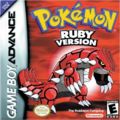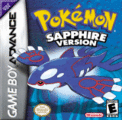Pokémon: Ruby and Sapphire Versions
 
| |
| Pokémon: Ruby and Sapphire Versions | |
| Developer | Game Freak |
| Publisher | Nintendo |
| System | Game Boy Advance |
| Release Date | JP November 21, 2002 US March 17, 2003 AU April 3, 2003 EU July 25, 2003 |
| Rating | ESRB: E |
Pokémon: Ruby Version and Pokémon: Sapphire Version are a pair of different versions of a handheld monster-collecting role-playing game that was released for the Game Boy Advance in 2003. These games mark the third generation of games in the Pokémon series and the first entries on the Game Boy Advance.
Story[edit]
Ruby and Sapphire follow the adventures of a young Pokémon trainer initially living in Littleroot Town who previously lived in Johto. In this game, the player has the option of playing a boy or a girl, with the other gender's character becoming a friendly rival of the player character.
This game features journeys across a new region know as Hoenn. The player battles trainers and earns badges from facing eight gym leaders in order to earn a shot at the Pokémon League championship. At the same time, the player must thwart the efforts of a local radical organization that seeks to change the land to reflect their own ideals. In Ruby, the enemies are Team Magma, who seek to wake Groudon in order to expand the land for them. In Sapphire, the enemies are Team Aqua, who seek to wake Kyogre in order to expand the oceans.
Gameplay[edit]
Ruby and Sapphire retains most of the basic gameplay of the previous Pokémon games while adding 135 new Pokémon to the series, bringing the total amount of Pokémon up to 385. These versions also introduce Natures and Abilities for each Pokémon, as well as different weather conditions that can come into play during battle, which deepen the gameplay and strategies associated with Pokémon battles.
One of the new features added in Ruby and 'Sapphire is the Pokémon Contests. The Contests are similar to pet shows in real life, in which the player must try to impress the judges with their Pokémon. There is also a system of collecting berries and planting berry trees. Berries can be held by Pokémon during battle to initiate different effects and can also be made into Pokéblocks that can be used to increase Pokémon's attributes for Contests. One of the features introduced in Crsytal remains, namely the choosing of the player character's gender. This game does not retain the second generation's day/night system, but it does keep the ability to tell different days of the week.
These games also added double battles, in which trainers fight with two Pokémon out at a time.
Connectivity[edit]
Ruby and Sapphire can connect with each other and trade as well as trade with Emerald, FireRed and LeafGreen using a Link Cable. However, none of these games are able to trade with older games due to changes in the game's code. Thus, linking to FireRed and LeafGreen is one of the only ways of getting many of the original 250 Pokémon in Ruby and Sapphire.
Through the Gamecube/Game Boy Advance Link, players can store their Pokémon in Pokémon Box. Certain bonuses can be transferred from Pokémon Colosseum to Ruby and Sapphire, including the hidden legendary Pokémon Jirachi. These games also make use of the e-Reader; there are certain islands containing rare Pokémon that can only be reached by using an e-Reader and a special promotional card.
The pair of games can also connect to Pokémon Diamond and Pearl using the dongle method. This can only be done once the player sees all 150 Pokémon in Diamond and Pearl. The Pokémon from 'Ruby and Sapphire can be transferred to those games through this method and cannot be traded back if so.
Version Differences[edit]
In all regions, Pokémon Ruby and Sapphire released simultaneously. In order to increase player interactivity, each version had exclusive Pokémon. There were also storyline differences between the two games; in Ruby Team Magma served as the main adversaries while Team Aqua was the main enemy of Sapphire. The games also had version-exclusive legendary Pokémon, which was a first in the series.
There were also more Pokémon that could only be found in Pokémon FireRed and Pokémon LeafGreen.
Legacy[edit]
This game introduced a number of features that were retained by following Pokémon games, such as Pokémon Contests and berries. Abilities, Natures and weather conditions also became standard parts of most Pokémon games. These were also the first core games to feature a plot centered around legendary Pokémon, which was something that most later games utilized as well, including making Legendary Pokémon version-exclusive. These installments also solidified the concept of choosing the player character's gender, which had been introduced in Crystal, and also introduces the idea of the unused gender being used for a rival character. All following Pokémon games, including remakes of past games, would include the option to choose the player character's gender.
Ruby and Sapphire also inspired a number of spin-off games such as Pokémon Pinball: Ruby & Sapphire, Pokémon Trozei! and Pokémon Channel. Pokémon from the third generation also made non-playable appearances in the Super Smash Bros. series starting in Super Smash Bros. Brawl.
Ports and Remakes[edit]
- In 2001 a third version, Pokémon: Emerald Version, was released. This game featured a story in which both Teams Aqua and Magma were involved as antagonists, rather than just one of them. This game also added a new feature known as the Battle Frontier.
- In 2014, these games received sixth generation remakes for the Nintendo 3DS that were known as Omega Ruby and Alpha Sapphire. These versions expanded the storyline and provided a graphics overhaul while implementing various features from the sixth generation games such as Mega Evolution.
Sequels[edit]
These games were followed up by the fourth generation games, Pokémon: Diamond and Pearl Versions.
| Mainstream titles of the Pokémon Series |
|---|
| I: Red/Green/Blue (Yellow - FireRed/LeafGreen - Let's Go, Eevee/Pikachu!) - II: Gold/Silver (Crystal - HeartGold/SoulSilver) III: Ruby/Sapphire (Emerald - Omega Ruby/Alpha Sapphire) - IV: Diamond/Pearl (Platinum - Brilliant Diamond/Shining Pearl) - V: Black/White (2) VI: X/Y - VII: Sun/Moon (Ultra) - VIII: Sword/Shield - Pokémon Legends: Arceus - IX: Scarlet/Violet |